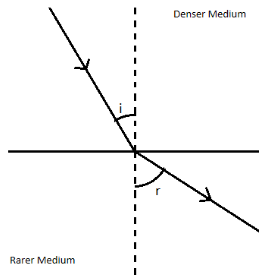
The velocities of light in two different media are
A.
B.
C.
D.
Answer
477.6k+ views
Hint:Critical angle is the minimum angle of incidence required for the light for total internal reflection to occur. The speed of light is lesser in denser medium and more in rarer medium.
Complete step by step answer:
Refraction is defined as the process in which light travels from one medium to another.During refraction, a change in velocity and wavelength of light occurs, whereas frequency remains constant. Light travels faster in rarer medium and slower in denser medium.

In the above figure, the light ray approaching the junction of two media is known as incident ray. And the light ray leaving the junction is known as refracted ray. The angle which incident ray forms with the normal is known as the incident angle
When the light travels from denser medium to rarer medium, its velocity increases and angle of incidence is greater than angle of refraction. As we start increasing the angle of incidence, the angle of refraction also increases. At a specific angle of incidence, the angle of refraction becomes
The value of critical angle can be given by Snell’s law, that is
Where,
Now we know that,
Where,
So,
Where,
Hence, the correct answer is option B.
Note:Total Internal reflection is the basis of modern technology. Since most of the modern technology is based on the transaction and transfer of data and how fast one can achieve it. Now total internal reflection uses light, and no other entity discovered has a speed greater than that of light, thus total internal reflection is the fastest possible way for the transfer of data.
Complete step by step answer:
Refraction is defined as the process in which light travels from one medium to another.During refraction, a change in velocity and wavelength of light occurs, whereas frequency remains constant. Light travels faster in rarer medium and slower in denser medium.

In the above figure, the light ray approaching the junction of two media is known as incident ray. And the light ray leaving the junction is known as refracted ray. The angle which incident ray forms with the normal is known as the incident angle
When the light travels from denser medium to rarer medium, its velocity increases and angle of incidence is greater than angle of refraction. As we start increasing the angle of incidence, the angle of refraction also increases. At a specific angle of incidence, the angle of refraction becomes
The value of critical angle can be given by Snell’s law, that is
Where,
Now we know that,
Where,
So,
Where,
Hence, the correct answer is option B.
Note:Total Internal reflection is the basis of modern technology. Since most of the modern technology is based on the transaction and transfer of data and how fast one can achieve it. Now total internal reflection uses light, and no other entity discovered has a speed greater than that of light, thus total internal reflection is the fastest possible way for the transfer of data.
Latest Vedantu courses for you
Grade 11 Science PCM | CBSE | SCHOOL | English
CBSE (2025-26)
School Full course for CBSE students
₹41,848 per year
Recently Updated Pages
Master Class 12 Economics: Engaging Questions & Answers for Success

Master Class 12 Maths: Engaging Questions & Answers for Success

Master Class 12 Biology: Engaging Questions & Answers for Success

Master Class 12 Physics: Engaging Questions & Answers for Success

Master Class 12 Business Studies: Engaging Questions & Answers for Success

Master Class 12 English: Engaging Questions & Answers for Success

Trending doubts
Which one of the following is a true fish A Jellyfish class 12 biology CBSE

Which are the Top 10 Largest Countries of the World?

a Tabulate the differences in the characteristics of class 12 chemistry CBSE

Why is the cell called the structural and functional class 12 biology CBSE

Differentiate between homogeneous and heterogeneous class 12 chemistry CBSE

Derive an expression for electric potential at point class 12 physics CBSE




